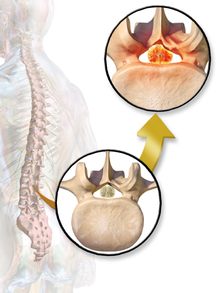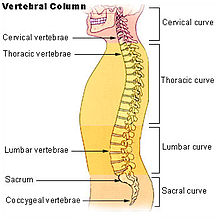用戶:Shangkuanlc/脊椎狹窄症候群
| Spinal stenosis | |
|---|---|
 | |
| Lumbar trefoil canal | |
| 分類和外部資源 | |
| MedlinePlus | 000441 |
Spinal stenosis is an abnormal narrowing (stenosis) of the spinal canal that may occur in any of the regions of the spine. This narrowing causes a restriction to the spinal canal, resulting in a neurological deficit. Symptoms include pain, numbness, paraesthesia, and loss of motor control. The location of the stenosis determines which area of the body is affected.[1] With spinal stenosis, the spinal canal is narrowed at the vertebral canal, which is a foramen between the vertebrae where the spinal cord (in the cervical or thoracic spine) or nerve roots (in the lumbar spine) pass through.[2] There are several types of spinal stenosis, with lumbar stenosis and cervical stenosis being the most frequent. While lumbar spinal stenosis is more common, cervical spinal stenosis is more dangerous because it involves compression of the 脊髓 whereas the lumbar spinal stenosis involves compression of the 脊髓.
Types[編輯]
The most common forms are cervical spinal stenosis, at the level of the neck, and lumbar spinal stenosis, at the level of the lower back. Thoracic spinal stenosis, at the level of the mid-back, is much less common.[1]
In lumbar stenosis, the spinal nerve roots in the lower back are compressed which can lead to symptoms of sciatica (tingling, weakness, or numbness that radiates from the low back and into the buttocks and legs).
Cervical spinal stenosis can be far more dangerous by compressing the spinal cord. Cervical canal stenosis may lead to serious symptoms such as major body weakness and paralysis. Such severe spinal stenosis symptoms are virtually absent in lumbar stenosis, however, as the spinal cord terminates at the top end of the adult lumbar spine, with only nerve roots (cauda equina) continuing further down.[3] Cervical spinal stenosis is a condition involving narrowing of the spinal canal at the level of the 頸. It is frequently due to chronic degeneration,[4] but may also be congenital or traumatic. Treatment frequently is surgical.[4]
Signs and symptoms[編輯]

Common[編輯]
- Standing discomfort (94%)
- Numbness (63%)
- Weakness (43%)
- Bilateral symptoms (68%)
- Discomfort/pain, in shoulder, arm, hand(78%)
- Buttock / Thigh only (8%)
- Below the knee (3%)[5]
Neurological disorders[編輯]
- Pinched nerve,[6] causing numbness.
- Intermittent neurogenic claudication [5][7][8] characterized by lower limb numbness, weakness, diffuse or radicular leg pain associated with paresthesis (bilaterally),[7] weakness heaviness in buttocks radiating into lower extremities with walking or prolonged standing.[5] Symptoms occur with extension of spine and are relieved with spine flexion. Minimal to zero symptoms when seated or supine.[5]

- Radiculopathy (with or without radicular pain) [7] neurologic condition - nerve root dysfunction causes objective signs such as weakness, loss of sensation and of reflex.
- Cauda equina syndrome [9] Lower extremity pain, weakness, numbness that may involve 會陰 and buttocks, associated with bladder and bowel dysfunction.
Other[編輯]
- Fever
- Nocturnal pain
- Gait disturbance
- Structural deformity
- Unexplained weight loss
- Previous 癌
- Severe pain upon lying down
- Recent trauma with suspicious fracture
- Presence of severe or progressive 神經內科 deficit [9]
- Lower back pain [5][8] due to degenerative disc or joint changes [10]
- Narrowing of spinal canal, nerve root canal or intervertebral Canal Stenosis: Start with nonsurgical therapy. Cleveland ral foramina [8]
Causes[編輯]
Aging: All the factors below may cause the spaces in the spine to narrow,
- Body’s 韌帶 can thicken (ligamentum flavum)
- 骨贅 develop on the bone and into the spinal canal
- 椎間盤 may bulge or herniate into the canal
- Facet joints break down
- Compression fractures of the spine, which are common in osteoporosis
- Cysts form on the facet joints causing compression of the spinal sac of nerves (thecal sac)
Arthritis: Two types,
Heredity:
- Spinal canal is too small at birth
- Structural deformities of the vertebrae may cause narrowing of the spinal canal
Instability of the spine, or 脊椎前移:
- A vertebra slips forward on another
Trauma:
- Accidents and injuries may dislocate the spine and the spinal canal or cause burst fractures that yield fragments of bone that go through the canal [11]
新生物 of the spine:
- Irregular growths of soft tissue will cause inflammation
- Growth of tissue into the canal pressing on nerves, the sac of nerves, or the spinal cord.
Diagnosis[編輯]
Making the diagnosis of spinal stenosis involves a complete evaluation of the spine. The process always begins with a medical history and physical examination.Imaging studies (x-ray, MRI, etc.) are often used to determine the extent and location of the nerve compression.
Medical history[編輯]
The medical history is the most important aspect of the examination as it will tell the physician about subjective symptoms, possible causes for spinal stenosis, and other possible causes of back pain.[12]
Physical examination[編輯]
The physical examination of a patient with spinal stenosis will give the physician information about exactly where nerve compression is occurring. Some important factors that should be investigated are any areas of sensory abnormalities, numbness, irregular 反射 (生理學), and any muscular weakness. [12]
MRI[編輯]
The 核磁共振成像 has become the most frequently used study to diagnose spinal stenosis. The MRI uses magnetic signals (instead of x-rays) to produce images of the spine. MRIs are helpful because they show more structures, including nerves, muscles, and ligaments, than seen on x-rays or X射線計算機斷層成像. MRIs are helpful at showing exactly what is causing spinal nerve compression.[12]
CT myelogram[編輯]
A spinal tap is performed in the low back with dye injected into the spinal fluid. X-Rays are performed followed by a CT scan of the spine to help see narrowing of the spinal canal. This is a very effective study in cases of lateral recess stenosis. It is also necessary for patients in which MRI is contraindicated, such as those with implanted pacemakers.
Treatments[編輯]
Non-surgical treatment[編輯]
The use of non surgical treatments is unclear as they have not been well studied.[13]
- Education about the course of the condition and how to relieve symptoms
- Exercise, to maintain or achieve overall good health, 有氧運動, such as riding a stationary bicycle, which allows for a forward lean, walking, or swimming can relieve symptoms
- Weight loss, to relieve symptoms and slow progression of the stenosis
- 物理治療, to provide education, instruction, and support for self-care; physical therapy instructs on stretching and strength exercises that may lead to a decrease in pain and other symptoms[14]
- Lumbar epidural steroid or anesthetic injections have low quality evidence to support their use.[13][15]
Surgery[編輯]
- Lumbar decompressive laminectomy - Removing the roof of bone overlying the spinal canal and thickened ligaments in order to decompress the nerves and sac of nerves. 70-90% of people have good results.[16]
- Interlaminar implant - A non-fusion U-shaped device which is placed between two bones in the lower back that maintains motion in the spine and keeps the spine stable after a lumbar decompressive surgery. The U-shaped device maintains height between the bones in the spine so nerves can exit freely and extend to lower extremities.[17]
- Anterior cervical discectomy and fusion - A surgical treatment of nerve root or spinal cord compression by decompressing the spinal cord and nerve roots of the cervical spine with a discectomy in order to stabilize the corresponding vertebrae.
Epidemiology[編輯]
- Swedish study defined spinal stenosis as a canal of 11mm or less found an incidence of 5 per 100,000 inhabitants.[18]
- National Low Back Pain Study recorded that out of 2,374 patients with low back pain, 35% had bone related spinal nerve compression.[來源請求]
- Data from National Ambulatory Medical Care survey suggests 13-14% of patients with low back pain may have spinal stenosis.[來源請求]
- The NAMCS data shows the incidence in the U.S. population to be 3.9% of 29,964,894 visits for mechanical back problems.[19]
- The Longitudinal Framingham Heart Study found 1% of men and 1.5% of women had vertebral slippage at mean age of 54. Over the next 25 years, 11% of men and 25% of women developed degenerative vertebral slippage.[20]
- 250,000-500,000 U.S. residents have symptoms of spinal stenosis.[來源請求]
References[編輯]
- ^ 1.0 1.1 Vokshoor A. Spinal Stenosis. eMedicine. February 14, 2010 [December 30, 2010].
- ^ Fast Facts About Spinal Stenosis. Niams.nih.gov. [2015-04-17].
- ^ Waxman, SG. Correlative Neuroanatomy 24th. 2000.
- ^ 4.0 4.1 Meyer F, Börm W, Thomé C; Börm; Thomé. Degenerative cervical spinal stenosis: current strategies in diagnosis and treatment. Dtsch Arztebl Int. May 2008, 105 (20): 366–72. PMC 2696878
 . PMID 19626174. doi:10.3238/arztebl.2008.0366 (不活躍 2015-05-09).
. PMID 19626174. doi:10.3238/arztebl.2008.0366 (不活躍 2015-05-09).
- ^ 5.0 5.1 5.2 5.3 5.4 Mazanec, D.J., Podichetty, V.K., Hsia, A. (2002) Lumbar Canal Stenosis: Start with nonsurgical therapy. Cleveland Clinic Journal of Medicine 69(11).
- ^ Cervical Radiculopathy (Pinched Nerve). AAOS. [13 December 2011].
- ^ 7.0 7.1 7.2 Costantini, A., Buchser, E., Van Buyten, J.P. (2009). Spinal Cord Stimulation for the Treatment of Chronic Pain in Patients with Lumbar Spinal Stenosis. Neuromodulation, 13(4), 275-380. doi:10.1111/j.1525-1403.2010.00289.x
- ^ 8.0 8.1 8.2 Goren, A., Yildiz, N., Topuz, O., Findikoglu, G., & Ardic, F. (2010). Efficacy of exercise and ultrasound in patients with lumbar spinal stenosis: A prospective randomized controlled trial. Clinical Rehabilitation, 24(7), 623-631. doi:10.1177/0269215510367539
- ^ 9.0 9.1 Doorly, T.P., Lambing, C.L., Malanga, G.A., Maurer, P.M., Ralph R., R. (2010). Algorithmic approach to the management of the patient with lumbar spinal stenosis. Journal of Family Practice, 59 S1-S8
- ^ Mazanec, D.J., Podichetty, V.K., Hsia, A. (2002) LumbarClinic Journal of Medicine 69(11).
- ^ Spinal stenosis Causes. Mayo Clinic. 2012-06-28 [2015-04-17].
- ^ 12.0 12.1 12.2 Cluett, Jonathan, M.D. (2010) Spinal Stenosis - How is Spinal Stenosis Diagnosed?
- ^ 13.0 13.1 Ammendolia, C; Stuber, KJ; Rok, E; Rampersaud, R; Kennedy, CA; Pennick, V; Steenstra, IA; de Bruin, LK; Furlan, AD. Nonoperative treatment for lumbar spinal stenosis with neurogenic claudication. The Cochrane database of systematic reviews. 30 August 2013, 8: CD010712. PMID 23996271. doi:10.1002/14651858.CD010712.
- ^ Lumbar Spinal Stenosis-Treatment Overview. Webmd.com. [2015-04-17].
- ^ Manchikanti, L; Kaye, AD; Manchikanti, K; Boswell, M; Pampati, V; Hirsch, J. Efficacy of epidural injections in the treatment of lumbar central spinal stenosis: a systematic review.. Anesthesiology and pain medicine. February 2015, 5 (1): e23139. PMID 25789241.
- ^ Malamut, edited by Joseph I. Sirven, Barbara L. Clinical neurology of the older adult 2nd. Philadelphia: Wolters Kluwer Health/Lippincott Williams & Wilkins. 2008: 220. ISBN 9780781769471.
- ^ coflex Interlaminar Technology - P110008. Fda.gov. 2014-01-17 [2015-04-17].
- ^ http://www.vancouverspinecarecentre.com/con_spinalstenosis[失效連結]
- ^ Spinal Stenosis Details. Spinalstenosis.org. [2015-04-17].
- ^ Treatment of Degenerative Lumbar Spinal Stenosis, Evidence Report/Technology Assessment, No. 32]. (2001). In AHRQ Archive. Retrieved 2/29/2012.
External links[編輯]
- Uvm.edu
- Ncbi.nlm.nih.gov
- Questions and Answers about Spinal Stenosis - US National Institute of Arthritis and Musculoskeletal and Skin Diseases
